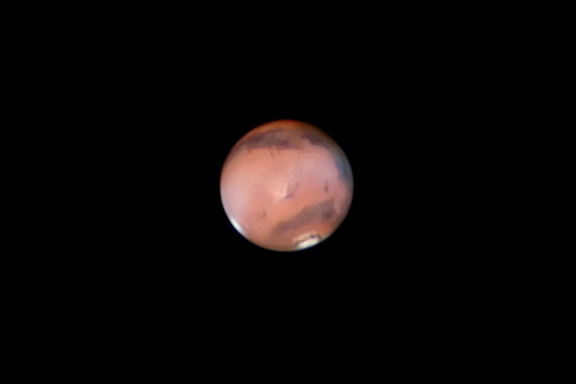 |
The rapid approach of summer in the northern hemisphere of Mars shows the North Polar Cap shrinking at lower right with a dark Lowell Band surrounding it, and with the Lemuria detachment of the polar cap next to the band. Orographic clouds can be seen over Elysium Planitia in the center of the disk and over Olympus Mons on the edge at lower left. Gomer Sinus are the two protrusions from Mare Cimmerium above Elysium at top. Syrtis Major is the large dark area rotating into view at upper right. Clouds can also be see in Lybia next to Syrtis Major.
This image was taken with a Celestron 11 Inch Edge HD f/10 Aplanatic Schmidt Cassegrain working at f/29 at 8,102 mm focal length with a 2.9x Barlow with a Canon EOS T2i (550D) with 4.3 micron pixels. The sampling was at 0.11 arcseconds per pixel. It was shot with 640 x 480 Movie Crop Mode at 60fps with a 1/60th second exposure at ISO 400. The video was 4 minutes and 4 seconds long and contained 12,632 frames. At the time of the image Mars's equatorial diameter was 13.7 arcseconds and it shone at magnitude -1.1 at an altitude of 59 degrees. The image was stacked in AutoStackkert!2, Sharpened in Registax 6 and further processed in Photoshop CS5.
|
Mars is the fourth planet from the Sun. It was named after the Roman God of war, probably because its red color which comes from the iron oxide (rust) in its soil.
It takes 686.971 Earth days for Mars to complete one orbit around the Sun.
Mars rotates on its own axis once every 1.025,957 Earth days or every 24 hours 37 min 22.66 sec. The length of a day on Mars is very similar to the length of a day on the Earth. To see the same feature on the central meridian of Mars, you must view it about 37 minutes later each day.
Mars has a diameter of 6,792.4 km (4,220.6 miles), about roughly half of the Earth's diameter of 12,742 km (7,917 miles).
Mars's brightness can vary from magnitude +1.6 to -3.0, and its size can vary from 3.5 to 25.1 arcseconds.
Although Mars appears as a biologically inactive world today, there is evidence that Mars has water, and in the past may have had rivers, lakes and even an ocean.
Imaging Mars
Because Mars's orbit lies outside of the orbit of the Earth, it comes to opposition when it is opposite the Sun in the sky and nearest to the Earth when it has its largest apparent diameter from our viewpoint. Mars can also exhibit phase effects depending on its location in relation to the Earth. Detail on Mars is best seen in the months around opposition, and particularly at those oppositions when Mars is closest to the Earth. Mars comes to opposition once every 764 to 812 days.
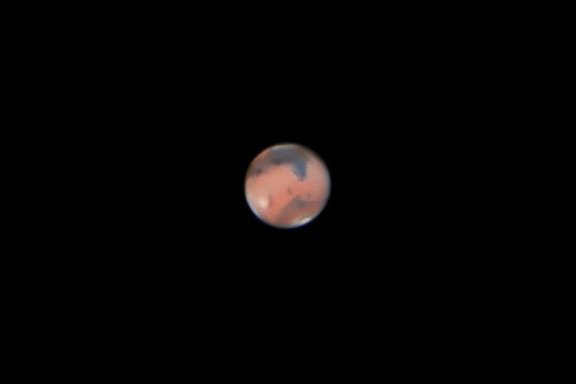 |
Syrtis Major is the largest dark albedo feature at upper right. Libya is the light plain next to Syrtis Major at top center of the disk of Mars. The morning limb at lower left has limb haze and just to the right are orographic clouds over the volcano Elysium Mons. Clouds can be seen over Hellas Basin at top. The north polar cap is at lower right.
This image was taken with a Celestron 11 Inch Edge HD f/10 Aplanatic Schmidt Cassegrain working at f/29 with a 2.9x Barlow at 8,102 mm focal length with a Canon EOS T2i (550D) with 4.3 micron pixels. The sampling was 0.11 arcseconds per pixel. It was shot with 640 x 480 Movie Crop Mode at 60fps at 1/60th second exposure at ISO 400. The video was 3 minutes and 2 seconds long and contained 10,955 frames. At the time of the image Mars's equatorial diameter was 13.8 arcseconds and it shone at magnitude -1.1 at an altitude of 55 degrees. The video was stacked in AutoStackkert!2, sharpened in Registax 6 and further enhanced in Photoshop CS5.
|
Mars has a highly elliptical orbit. Because of this its size can vary greatly at opposition. When it is closest to the Sun at perihelion and also at opposition to us at the same time, it will be closest to us and therefore have its largest apparent size. Favorable perihelic oppositions came at 15.8-year intervals and occur between late July and late September.
At the perihelic opposition in August of 2003, Mars subtended an apparent size of 25.1 arcseconds. By comparison, during the 2012 opposition, when the images in this section were taken, Mars's maximum apparent size was only 13.88 arcseconds in diameter.
| Coming Mars Oppositions |
|---|
| Date |
Size in Arc Sec |
Declination |
| April 8, 2014 |
15.1 |
-5.2 |
| May 22, 2016 |
18.4 |
-21.7 |
| July 27, 2018 |
24.3 |
-25.5 |
| October 13, 2020 |
22.3 |
+5.5 |
| December 8, 2022 |
17.0 |
+25.0 |
| January 16, 2025 |
14.6 |
+25.1 |
The declination tells you how high above, or below the celestial equator that Mars will be at opposition. This tells you how high in the sky the planet will be when it transits the meridian. For northern hemisphere observers, a positive declination puts Mars higher in the sky. The reverse is true for the southern hemisphere.
Martian Geologic and Surface Features
In a telescope, Mars's surface can display a wealth of detail. You can see and resolve more in an image if Mars is closer and larger.
Unlike Venus, Mars has a very thin atmosphere and the surface is easily visible, revealing some of the most interesting planetary detail in the solar system. Mars has fascinating surface details that can be observed and photographed, such as polar ice caps, volcanoes, light and dark albedo features, deserts, and clouds. Dust storms can sometimes even obscure much of the surface of Mars and last for long periods of time.
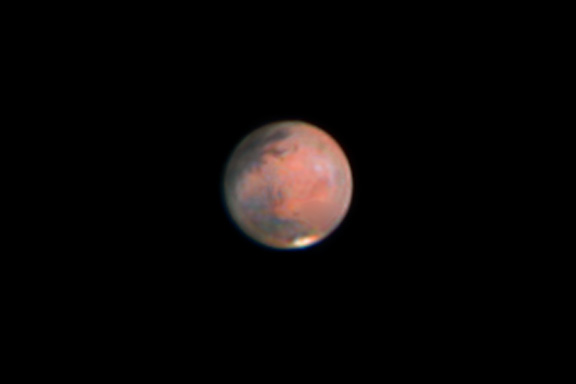 |
The Tharsis region is centered on the planet in this image. Mare Acidalium is the dark area to lower left. Solis Lacus, Aurorae Sinus and Mare Erythraeum are at top. Amazonis Planitia is at right. The north polar cap is visible at bottom on the planet.
Taken with a Celestron 11 Inch Edge HD f/10 Aplanatic Schmidt Cassegrain working at f/20 with a 2x Barlow at 5,588 mm of focal length with a Canon EOS T2i (550D) with 4.3 micron pixels. Sampling was at 0.158 arcseconds per pixel. The Live View was recorded with Images Plus Camera Control as an SID file format shooting at 1/100th second exposure at ISO 400. The video contained 658 frames. At the time of the image Mars's equatorial diameter was 13.5 arcseconds and it shone at Magnitude -1.0 at an altitude of 58 degrees. The video was converted to BMPs and stacked in AutoStackkert!2, sharpened in Registax 6 and further enhanced in Photoshop CS5.
|
The following features are visible on Mars:
Martian Clouds and Hazes
Clouds can be found in many locations on Mars. Most clouds that form on Mars are related to the sublimation of carbon dioxide and water ice in the polar caps, and the subsequent movement of these gases and vapors to areas where they eventually condense into clouds. Winter ice clouds on Mars are white but other hazes can be blue.
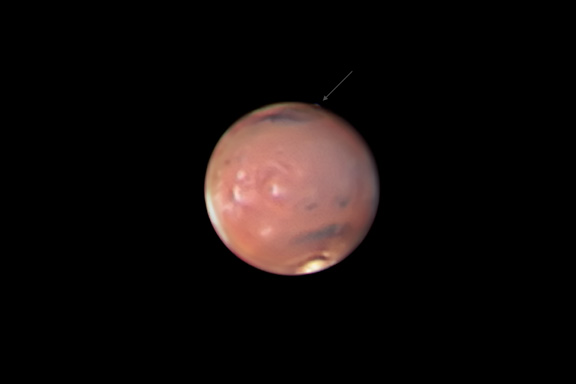 |
Mars is seen here showing an unusual terminator projection (arrowed), discovered by Wayne Jaeschke. The feature may be a high altitude or mesospheric cloud at an altitude of 40-80 kilometers above the surface illuminated by the Sun making it look projected from the planet because the area under it is still in shadow on the terminator. Volcano Olympus Mons can be seen just to the left of the center, surrounded by orographic clouds. Other clouds are visible to the left over Tharsis. The north polar cap is at the bottom with a dark Lowell band next to it.
This image was taken with a Celestron 11 Inch Edge HD f/10 Aplanatic Schmidt Cassegrain working at f/29 with a 2.8x Barlow at 8,102 mm of focal length with a Canon EOS T2i (550D) with 4.3 micron pixels. It was shot with 640 x 480 Movie Crop Mode at 60fps at 1/60th second exposure at ISO 400. The video was 6 minutes and contained 21,547 frames. The sampling was 0.11 arcseconds per pixel. At the time of the image Mars's equatorial diameter was 13.3 arcminutes and it shone at magnitude -0.9 at an altitude of 59 degrees. The video was stacked in AutoStackkert!2, sharpened in Registax 6 and further processed in Photoshop CS5.
|
There are many different kinds of clouds and hazes on Mars:
The Moons of Mars
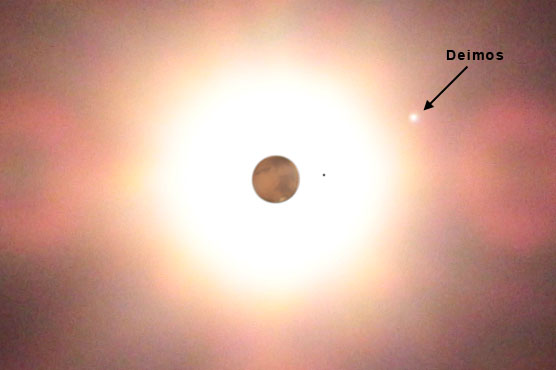 |
Mars's moon Deimos is visible next to a greatly overexposed image of Mars itself. A correctly exposed image of Mars is composited into the image at its correct size. Mars's other moon, Phobos, is lost in the glare from Mars because it orbits closer to the planet. The location of where it would have been is shown with a tiny black dot added next to Mars.
This image was taken with a Celestron 11 Inch Edge HD f/10 Aplanatic Schmidt Cassegrain working at f/10 at 2,709 mm of focal length with a Canon EOS T2i (550D). It was shot as a single frame with 30 seconds of exposure at ISO 1600.
|
Mars has two moons - Phobos and Deimos. They were discovered by Asaph Hall in 1877. To go along with the mythological nomenclature of Mars, Phobos means "fear" and Deimos means "dread", appropriate companions to the God of War.
Deimos has an average diameter of about 12 km (7.5 miles), but is irregularly shaped, like an asteroid. It shines at an average magnitude of 12.45. It orbits around Mars at a distance of about 23,458 km (14,576 miles). It takes Deimos 30.2976 hours to make one orbit around Mars.
Phobos has an average diameter of about 22 km (13.6 miles). It is the brighter of the two moons, shining at magnitude 11.4. It orbits closer to Mars than Deimos however, at an average distance of only 6,000 km (3,700 miles) above the surface of the planet. It takes Phobos just 7.65 hours to orbit around Mars.
Sky & Telescope's Mars's Moons javascript utility gives the locations of Mars's moons for a given date and time.
It is difficult to photograph the moons of Mars because of the tremendous difference in brightness between them and the planet, and because Phobos orbits so close.
When the image above was taken, Mars shone at magnitude -1.2 and Deimos at magnitude 13.3. With the 14.4 magnitude difference, Mars was more than 1/2 million times brighter than Deimos. Each astronomical magnitude is brighter by a factor of 2.5119 (the fifth root of one hundred). Since the image was exposed for Deimos, Mars is tremendously overexposed. The large red circles on the sides of the image are reflections off the sensor.
Mars Global Map
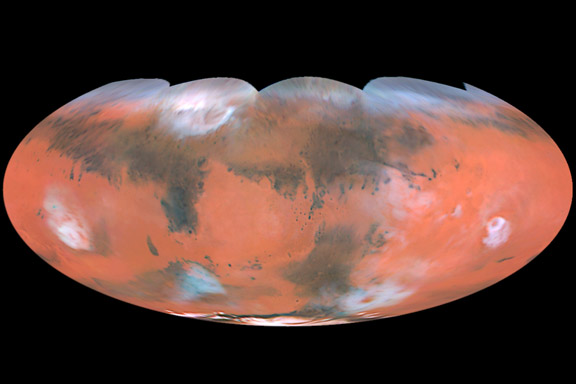
|
|
Hold your mouse cursor over the image to see feature identifications on the planet. This global map of Mars was combined from four hemispheric views taken by the Hubble Space Telescope. Image credit: Steve Lee (University of Colorado), Jim Bell (Cornell University), Mike Wolff (Space Science Institute), NASA.
|
Tips for Photographing Mars
|
Mars - The Bottom Line
Mars can get very bright at oppositions as it hangs in the sky like a fiery red beacon.
It also attains its largest apparent size at opposition, making this the best time to try to photograph Mars at high power to record its fascinating features and active weather and dust storms.
|
|